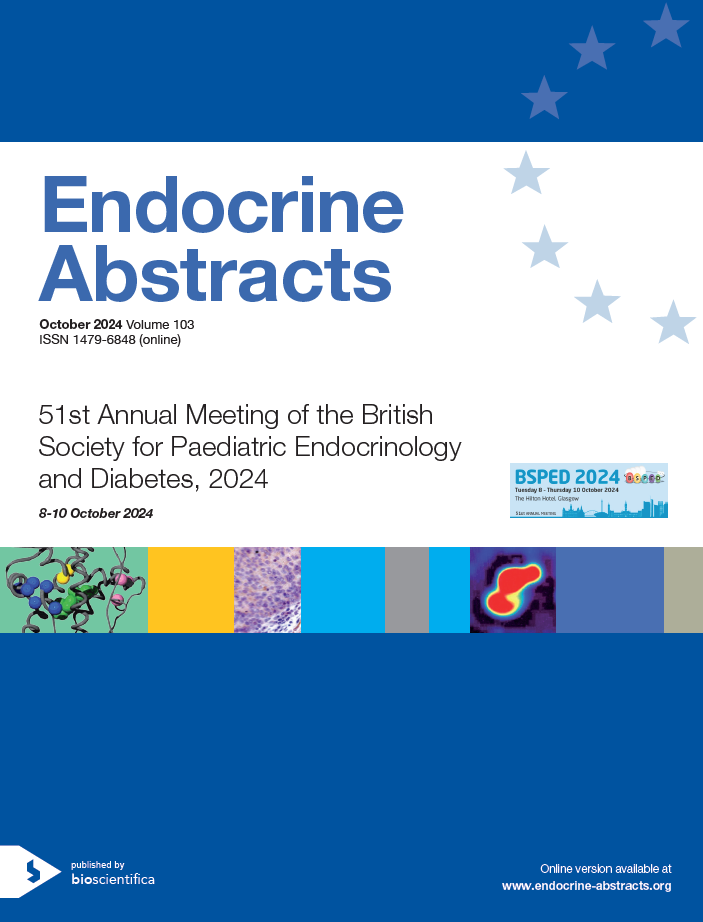
51st Annual Meeting of the British Society for Paediatric Endocrinology and Diabetes
Glasgow,
UK
08 Oct 2024 - 10 Oct 2024

Poster Presentations
Miscellaneous/Other 2
ea0103p114 | Miscellaneous/Other 2 | BSPED2024
Diazoxide hypersensitivity in neonatal hyperinsulinism due to HNF4A variants
Malhotra Neha , McGlacken-Byrne Sinead , Gilbert Clare , Morgan Kate , Ward Niamh , Dastamani Antonia
ea0103p115 | Miscellaneous/Other 2 | BSPED2024
Enzymes in endocrinology: gynaecomastia in a 5 year old boy
Sivasanker Banupriya , Howard Sasha
ea0103p116 | Miscellaneous/Other 2 | BSPED2024
Looking beyond the obvious in a case of precocious puberty
Apperley Louise , Jarvis Charlie , Walker Laura , Ramakrishnan Renuka
ea0103p117 | Miscellaneous/Other 2 | BSPED2024
Optimising risk stratification for aortopathy in turner syndrome using aortic size index
Fletcher Alexander James. , Carr Aoife , McVey Lindsey , Denvir Martin , Gebbie Ailsa , Guaragna-Filho Guilherme , Hunter Lindsey , Hutchinson Stuart , Joshi Shruti S. , de Lemos-Marini Sofia Helena. Valent. , Santoro Renata Isa. , Walker Nicola , Mason Avril , Wong Sze Choong.
ea0103p118 | Miscellaneous/Other 2 | BSPED2024
Hypoglycemia during treatment of acute lymphoblastic leukaemia [ALL] in children: case report series
Idris Azza , Williams Georgina , Pryce Rebekah , Moat Stuart , Connor Philip
ea0103p119 | Miscellaneous/Other 2 | BSPED2024
Genotes for clinicians – a genomic testing resource for paediatric endocrinologists
McGlacken-Byrne Sinead , Gohil Shailesh , Consortium GeNotes , Izatt Louise , Korbonits Marta , Levy Miles , Howard Sasha
ea0103p120 | Miscellaneous/Other 2 | BSPED2024
Usefulness of freestyle libre 3 CGM in detecting hypoglycaemia in two infants with diazoxide non-responsive hyperinsulinism
Tulloch Caitriona , Kiff Sarah , Chetty Tarini , Cox Kathryn , Miles Harriet , Elleri Daniela
ea0103p121 | Miscellaneous/Other 2 | BSPED2024
Management strategies and patient outcomes of congenital hyperinsulinism (CHI) related with beckwith-wiedemann syndrome (BWS) – insights from an CHI highly specialized centre
Morgan Kate , Gilbert Clare , Cunjamalay Annaruby , Dastamani Antonia
ea0103p122 | Miscellaneous/Other 2 | BSPED2024
Safety of lanreotide in infants with congenital hyperinsulinism
Malhotra Neha , Yan Georgina , Morgan Kate , Gilbert Clare , Gan Chin , Dastamani Antonia



